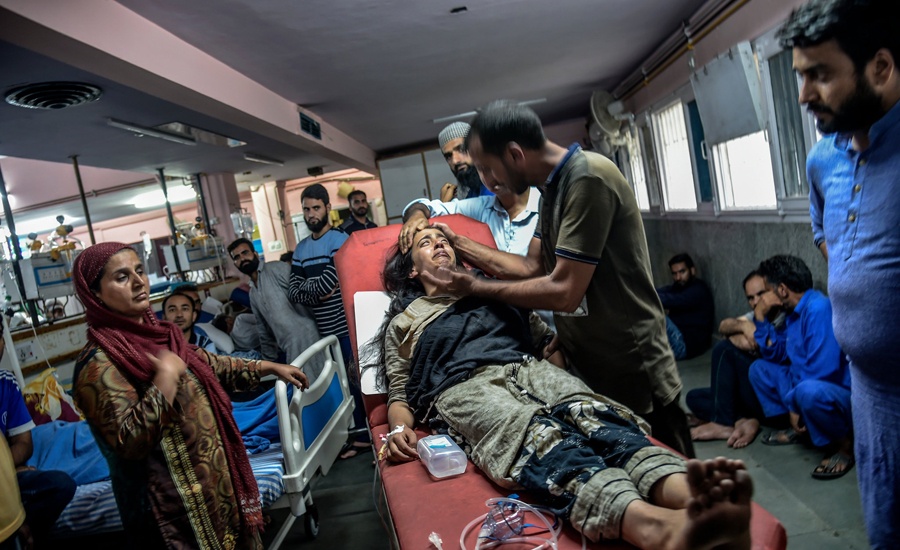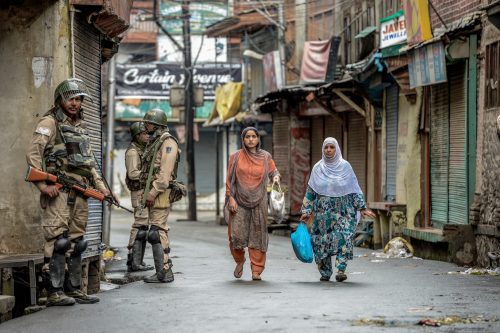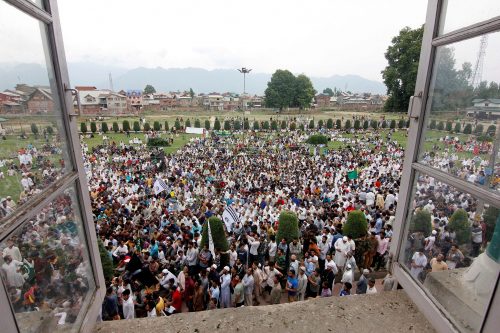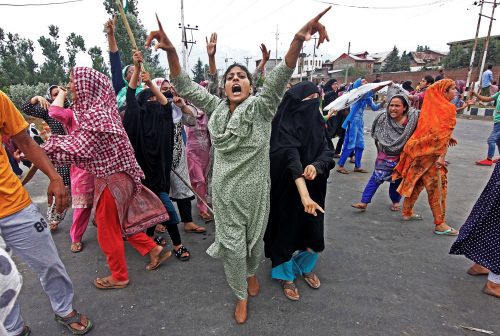Occupied Kashmir – a living hell of anger and fear: New York Times

SRINAGAR — On the streets of Srinagar, Kashmir’s biggest city, security officers tied black bandannas over their faces, grabbed their guns and took positions behind checkpoints. People glanced out the windows of their homes, afraid to step outside. Many were cutting back on meals and getting hungry.
A sense of coiled menace hung over the locked-down city and the wider region on Saturday, a day after a huge protest erupted into clashes between Kashmiris and Indian security forces.
Shops were shut. ATMs had run dry. Just about all lines to the outside world — internet, mobile phones, even landlines — remained severed, rendering millions of people incommunicado.
 Correspondents for The New York Times got one of the first inside views of life under lockdown in Kashmir and found a population that felt besieged, confused, frightened and furious by the seismic events of this week.
People who ventured out said they had to beg officers to cross a landscape of sandbags, battered trucks and soldiers staring at them through metal face masks. Several residents said they had been beaten up by security forces for simply trying to buy necessities like milk.
India’s swift and unilateral decision Monday to wipe out Occupied Kashmir’s autonomy significantly raised tensions with its archrival, Pakistan. The territory lying between the two nuclear armed nations was already one of Asia’s most dangerous and militarized flash points, smoldering for decades.
Correspondents for The New York Times got one of the first inside views of life under lockdown in Kashmir and found a population that felt besieged, confused, frightened and furious by the seismic events of this week.
People who ventured out said they had to beg officers to cross a landscape of sandbags, battered trucks and soldiers staring at them through metal face masks. Several residents said they had been beaten up by security forces for simply trying to buy necessities like milk.
India’s swift and unilateral decision Monday to wipe out Occupied Kashmir’s autonomy significantly raised tensions with its archrival, Pakistan. The territory lying between the two nuclear armed nations was already one of Asia’s most dangerous and militarized flash points, smoldering for decades.
 Anything dramatic or provocative that happens here — and India’s move was widely seen as both — instantly sends a jolt of anxiety across this entire region.
On Friday afternoon, witnesses said tens of thousands of peaceful demonstrators were moving through the streets of Srinagar, chanting freedom slogans and waving Kashmiri flags, when Indian forces opened fire.
The huge crowd panicked and scattered. Sustained bursts of automatic weapon fire could be heard in videos filmed during the protest, and at least seven people were wounded, hospital officials said, some sprayed by buckshot in the eyes.
Anything dramatic or provocative that happens here — and India’s move was widely seen as both — instantly sends a jolt of anxiety across this entire region.
On Friday afternoon, witnesses said tens of thousands of peaceful demonstrators were moving through the streets of Srinagar, chanting freedom slogans and waving Kashmiri flags, when Indian forces opened fire.
The huge crowd panicked and scattered. Sustained bursts of automatic weapon fire could be heard in videos filmed during the protest, and at least seven people were wounded, hospital officials said, some sprayed by buckshot in the eyes.
 Afshana Farooq, a 14-year-old girl, was nearly trampled in the stampede. “We were just marching peacefully after prayers,” said her father, Farooq Ahmed, standing over her as she lay shaking in a Srinagar hospital bed. “Then they started shooting at us.”
For the past three decades, the Occupied Kashmir Valley, part of the region controlled by India, has been a conflict zone, a restive area chafing for independence. In the 1990s, Pakistan opened the floodgates for jihadists to cross the border, setting off years of heavy fighting.
In the valley, nearly all of about 50 Kashmiris interviewed said they expected India’s actions to increase the sense of alienation and in turn feed the rebellion.
Afshana Farooq, a 14-year-old girl, was nearly trampled in the stampede. “We were just marching peacefully after prayers,” said her father, Farooq Ahmed, standing over her as she lay shaking in a Srinagar hospital bed. “Then they started shooting at us.”
For the past three decades, the Occupied Kashmir Valley, part of the region controlled by India, has been a conflict zone, a restive area chafing for independence. In the 1990s, Pakistan opened the floodgates for jihadists to cross the border, setting off years of heavy fighting.
In the valley, nearly all of about 50 Kashmiris interviewed said they expected India’s actions to increase the sense of alienation and in turn feed the rebellion.
 Elders in several rural areas reported that dozens of young men had already disappeared from their communities.
Kashmiris are desperate to get information. But with the internet out and phones and television service disrupted, space has been created for the wildest rumors. A few small Kashmiri newspapers have continued unbowed, putting out thin paper editions — four pages, maybe eight — that are carefully passed hand to hand throughout the day.
Several people said they were feeling so anxious that they couldn’t sleep. “Sleep has vanished,” Mr. Ahmad said. “We don’t trust anyone.”
Elders in several rural areas reported that dozens of young men had already disappeared from their communities.
Kashmiris are desperate to get information. But with the internet out and phones and television service disrupted, space has been created for the wildest rumors. A few small Kashmiri newspapers have continued unbowed, putting out thin paper editions — four pages, maybe eight — that are carefully passed hand to hand throughout the day.
Several people said they were feeling so anxious that they couldn’t sleep. “Sleep has vanished,” Mr. Ahmad said. “We don’t trust anyone.”
 Correspondents for The New York Times got one of the first inside views of life under lockdown in Kashmir and found a population that felt besieged, confused, frightened and furious by the seismic events of this week.
People who ventured out said they had to beg officers to cross a landscape of sandbags, battered trucks and soldiers staring at them through metal face masks. Several residents said they had been beaten up by security forces for simply trying to buy necessities like milk.
India’s swift and unilateral decision Monday to wipe out Occupied Kashmir’s autonomy significantly raised tensions with its archrival, Pakistan. The territory lying between the two nuclear armed nations was already one of Asia’s most dangerous and militarized flash points, smoldering for decades.
Correspondents for The New York Times got one of the first inside views of life under lockdown in Kashmir and found a population that felt besieged, confused, frightened and furious by the seismic events of this week.
People who ventured out said they had to beg officers to cross a landscape of sandbags, battered trucks and soldiers staring at them through metal face masks. Several residents said they had been beaten up by security forces for simply trying to buy necessities like milk.
India’s swift and unilateral decision Monday to wipe out Occupied Kashmir’s autonomy significantly raised tensions with its archrival, Pakistan. The territory lying between the two nuclear armed nations was already one of Asia’s most dangerous and militarized flash points, smoldering for decades.
 Anything dramatic or provocative that happens here — and India’s move was widely seen as both — instantly sends a jolt of anxiety across this entire region.
On Friday afternoon, witnesses said tens of thousands of peaceful demonstrators were moving through the streets of Srinagar, chanting freedom slogans and waving Kashmiri flags, when Indian forces opened fire.
The huge crowd panicked and scattered. Sustained bursts of automatic weapon fire could be heard in videos filmed during the protest, and at least seven people were wounded, hospital officials said, some sprayed by buckshot in the eyes.
Anything dramatic or provocative that happens here — and India’s move was widely seen as both — instantly sends a jolt of anxiety across this entire region.
On Friday afternoon, witnesses said tens of thousands of peaceful demonstrators were moving through the streets of Srinagar, chanting freedom slogans and waving Kashmiri flags, when Indian forces opened fire.
The huge crowd panicked and scattered. Sustained bursts of automatic weapon fire could be heard in videos filmed during the protest, and at least seven people were wounded, hospital officials said, some sprayed by buckshot in the eyes.
 Afshana Farooq, a 14-year-old girl, was nearly trampled in the stampede. “We were just marching peacefully after prayers,” said her father, Farooq Ahmed, standing over her as she lay shaking in a Srinagar hospital bed. “Then they started shooting at us.”
For the past three decades, the Occupied Kashmir Valley, part of the region controlled by India, has been a conflict zone, a restive area chafing for independence. In the 1990s, Pakistan opened the floodgates for jihadists to cross the border, setting off years of heavy fighting.
In the valley, nearly all of about 50 Kashmiris interviewed said they expected India’s actions to increase the sense of alienation and in turn feed the rebellion.
Afshana Farooq, a 14-year-old girl, was nearly trampled in the stampede. “We were just marching peacefully after prayers,” said her father, Farooq Ahmed, standing over her as she lay shaking in a Srinagar hospital bed. “Then they started shooting at us.”
For the past three decades, the Occupied Kashmir Valley, part of the region controlled by India, has been a conflict zone, a restive area chafing for independence. In the 1990s, Pakistan opened the floodgates for jihadists to cross the border, setting off years of heavy fighting.
In the valley, nearly all of about 50 Kashmiris interviewed said they expected India’s actions to increase the sense of alienation and in turn feed the rebellion.
 Elders in several rural areas reported that dozens of young men had already disappeared from their communities.
Kashmiris are desperate to get information. But with the internet out and phones and television service disrupted, space has been created for the wildest rumors. A few small Kashmiri newspapers have continued unbowed, putting out thin paper editions — four pages, maybe eight — that are carefully passed hand to hand throughout the day.
Several people said they were feeling so anxious that they couldn’t sleep. “Sleep has vanished,” Mr. Ahmad said. “We don’t trust anyone.”
Elders in several rural areas reported that dozens of young men had already disappeared from their communities.
Kashmiris are desperate to get information. But with the internet out and phones and television service disrupted, space has been created for the wildest rumors. A few small Kashmiri newspapers have continued unbowed, putting out thin paper editions — four pages, maybe eight — that are carefully passed hand to hand throughout the day.
Several people said they were feeling so anxious that they couldn’t sleep. “Sleep has vanished,” Mr. Ahmad said. “We don’t trust anyone.”







